Lines and planes [9.5]

Casa Batlló by Antoni "enemy of the straight line" Gaudí
and Josep Maria Jujol.
Line segment
You know that "two points determine a line".
In 3-d we should be able to construct a line given:
2 points $\times$ 3 coordinates / pt = 6 numbers.
In yesterday's class, you figured out (in two dimensions) that this equation specifies all the points on the line segment between $P$ and $Q$
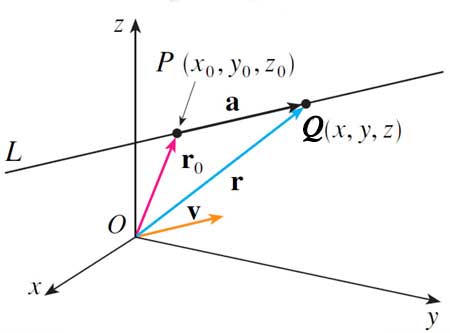
$$(\,x(t), y(t)\ )= (P_x,P_y) +t( \myv{PQ}_x, \myv{PQ}_y )\ :\ 0\lt t \lt 1.$$
You figured out that if we lifted the restriction $0\lt t \lt 1$, and allowed $t$ to be any real number, positive or negative, that we'd have the equation of the line that runs through both $P$ and $Q$!
Translating this into the terms of the diagram above (and generalizing to 3 dimensions...)
- $\myv r_0$ is the position vector with tail at the origin, and head at point $P$.
- $\myv{PQ}\equiv \myv a$ is the difference vector, which runs from $P$ to some other point $Q$
- Let's say that $\myv v$ is some other vector, that is parallel to $\myv a$. Any vector parallel to $\myv v$ can be expressed as some scalar multiple $t\myv v$ of $v$.
So, using vector addition, we can express the set of points on the line in parametric form as: $$\myv r(t)=\myv r_0 + t\myv v.$$
- Tip: WebAssign problem 9.5.002 In part 1 of this question, they ask you for the "vector equation of a line". They're expecting
$$r_0+tv$$
with no special vector formatting.
To get the subscript, type 'r_0`. When you type the underscore character, '_', you won't see it appear, but when you type the 0, it should show up as a subscript.
...And since $\myv r_0$ and $\myv v$ each have three components, once again, we have the 6 scalars needed to uniquely specify a line, only packaged up this time as the coordinates of a point and the components of a vector.
In component form
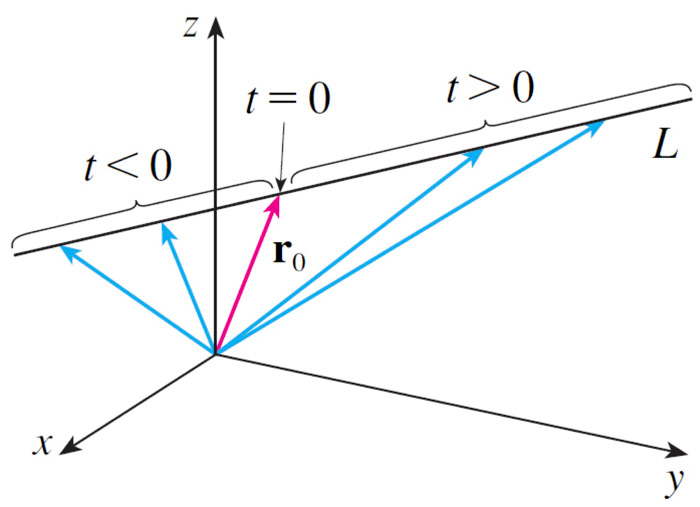 $$\begineq \myv r(t) &=& \myv r_0 + t\myv v = \langle x_0,y_0,z_0\rangle+t\langle a,b,c\rangle \\
&=& \langle x_0+ta, y_0+tb, z_0+tc \rangle
.\endeq
$$
or
$$x(t)=x_0 +at;\ \ y(t)=y_0 +bt;\ \ z(t)=z_0 +ct$$
$$\begineq \myv r(t) &=& \myv r_0 + t\myv v = \langle x_0,y_0,z_0\rangle+t\langle a,b,c\rangle \\
&=& \langle x_0+ta, y_0+tb, z_0+tc \rangle
.\endeq
$$
or
$$x(t)=x_0 +at;\ \ y(t)=y_0 +bt;\ \ z(t)=z_0 +ct$$
Each of these can be solved for $t$, and then setting each form of $t$ to the others: $$\frac{x-x_0}{a}=\frac{y-y_0}{b}=\frac{z-z_0}{c}.$$
These are the symmetric equations. Notice that $a$, $b$, $c$ are the components of $\myv v$, a vector parallel to the line $L$.
Example
Consider two lines: $$\nonumber x=1+t;\ \ y=-2+3t;\ \ z=4-t$$ and $$\nonumber x=2s;\ \ y=3+s;\ \ z=-3+4s$$
Do they intersect?
Solution: If they intersect at some common point (x,y,z), then that point should be a simultaneous solution in $s$ and $t$ to these three equations: $$1+t=2s;\ \ -2+3t=3+s;\ \ 4-t=-3+4s$$
Those same two lines: $$\nonumber x=1+t;\ \ y=-2+3t;\ \ z=4-t$$ and $$\nonumber x=2s;\ \ y=3+s;\ \ z=-3+4s$$
Are the lines parallel?
Solution: Re-arrange the equations into the form of the symmetric equations (solve each equation for $t$...or for $s$...) to find the components (denominators) of a vector parallel to each line.
Lines which are not parallel to each other, and do not intersect are called skew lines.
Line segment
How to specify a line segment that connects two points, specified by 2 vectors (from the origin) $\myv r_0$ and $\myv r_1$?
Using a parameter $0 \leq t\leq 1$, we can certainly arrange to have the point be $\myv r_0$ when $t=0$, and $\myv r_1$ when $t=1$ by doing this: $$\myv r(t) = (1-t)\myv r_0 + t\myv r_1.$$ You can re-arrange this as: $$\myv r(t)=\myv r_0 +t(\myv r_1-\myv r_0)=\myv r_0+t\myv v$$ where $\myv v \equiv \myv r_1-\myv r_0$ is the difference vector between the two points.
But does this produce a line connecting the two points? Or something else?
Trying it in two dimensions...
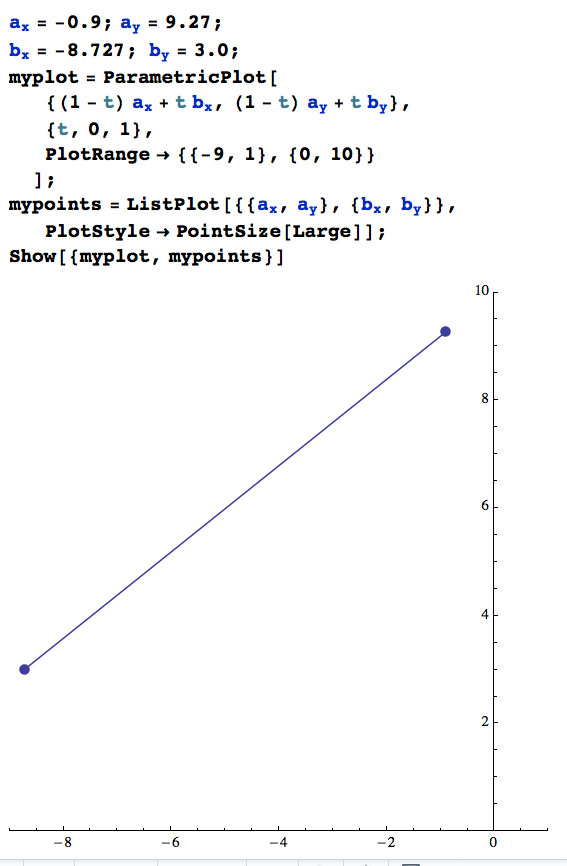
To do
- Lines in the plane
Planes
A plane can be determined by
- a point $P_0$ in the plane and
- a normal vector, $\myv n$, which is orthogonal (normal) to the plane.
In pictures...
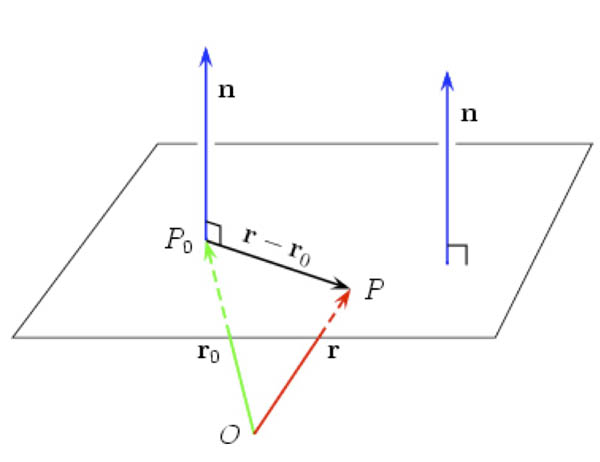
- $\myv r_0=\langle x_0, y_0, z_0 \rangle$ is a vector pointing at $P_0$.
- $\myv n = \langle a, b, c \rangle$ is the normal vector.
- $\myv r=\langle x,y,z\rangle$: Some point in the plane, which must satisfy the condition that $\myv r -\myv r_0$ is perpendicular to $\myv n$:
$$\begineq 0&=&\myv n \cdot (\myv r-\myv r_0)\\ &=&\langle a,b,c \rangle \cdot \langle x-x_0,y-y_0,z-z_0\rangle\\ 0&=&a(x-x_0)+b(y-y_0)+c(z-z_0)\rangle\\ \endeq $$
Pushing the equation above one step further, let's expand the products and add up all the constant terms calling their sum $k$: $$\begineq ax_0+by_0+cz_0&=&ax+by+cz\\ k&=&ax+by+cz \endeq $$
So that if you see an equation for a plane such as: $$56=7x-3y+2z,$$ You can just read off the components of a normal vector to the plane as: $$\myv n=\langle 7,-3,2 \rangle.$$
Example
Example four from book, but using a cross product to find the surface normal...
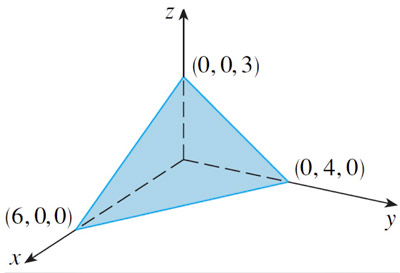
First find the normal to the plane.
[Find two vectors that are in the plane, and then take their cross product.]
Then find the equation for the plane.
[Take as $\myv r_0$ any of the three points shown.]
Find the surface normal:
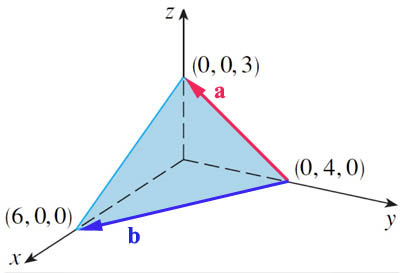 $\myv a=\langle 0,-4,3 \rangle$
$\myv a=\langle 0,-4,3 \rangle$
$\myv b=\langle 6,-4,0 \rangle$
$\myv a \times \myv b=12\uv i+18\uv j+24\uv k$
Let's take for the normal vector... $$\myv n=2\uv i+3\uv j+4\uv k =a \uv i + b \uv j +c \uv k$$
Picking $(0,4,0)$ as the point in the plane, then the prescription above is... $$\begineq 0 &=&a(x-x_0)+b(y-y_0)+c(z-z_0)\\ &=&2(x)+3(y-4)+4(z) = 2x+3y-12+4z\\ \endeq$$ So, the equation for the plane can be written as: $$2x+3y+4z = 12.$$ where a normal vector to the plane was $\myv n=\myc{2,3,4}$.
Notice that when the equation for a plane is written in this form that you can read off the components of the normal vector from the coefficients of $x$, $y$, and $z$!
Using algebra, find the intersection of the planes $x+2y+z=4$ and $4x+2y+3z=12$ in parametric form: For example, you could...
- solve the first equation for $z$ (which depends on $x$ and $y$),
- substitute $z$ into the second equation and solve it for $y$ in terms of $x$, that is $y(x)$.
- go back to your equation for $z(x,y)$. Substitute in your equation $y(x)$ to find z(x).
Confirm by graphing the two planes and the line...